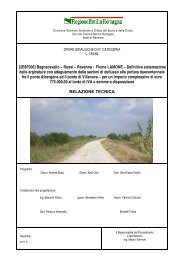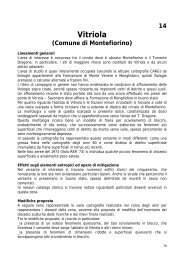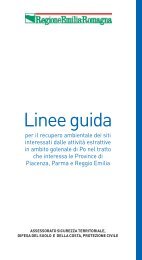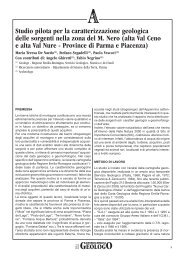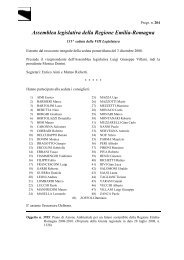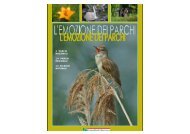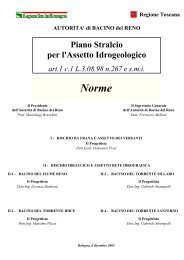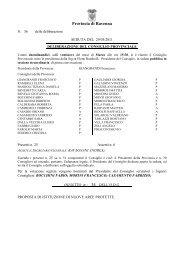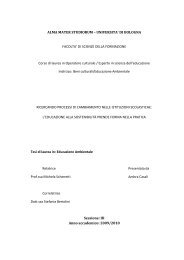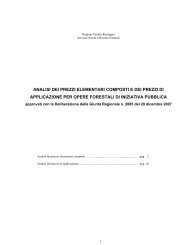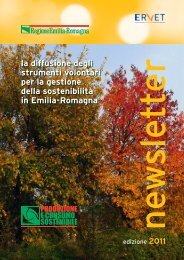air, water and soil quality qualité - ER Ambiente - Regione Emilia ...
air, water and soil quality qualité - ER Ambiente - Regione Emilia ...
air, water and soil quality qualité - ER Ambiente - Regione Emilia ...
Create successful ePaper yourself
Turn your PDF publications into a flip-book with our unique Google optimized e-Paper software.
BEHAVIOR OF ORGANIC POLLUTANTS IN THE SOIL<br />
ENVIRONMENT. SPECIAL FOCUS ON GLYPHOSATE AND AMPA<br />
COMPORTEMENT DES AGENTS POLLUANTS ORGANIQUES DANS LE<br />
SOL. AVEC MENTION SUR LE GLYPHOSATE ET AMPA<br />
COMPORTAMENTO DEGLI INQUINANTI ORGANICI<br />
NELL’AMBIENTE DEL SUOLO.<br />
FOCUS SPECIALE SU GLYPHOSATE E AMPA<br />
Summary<br />
Gorana Rampazzo Todorovic<br />
University of Natural Resources <strong>and</strong> Applied Life Sciences, Wien<br />
E.mail: gorana.todorovic@boku.ac.at<br />
In industrialized countries, <strong>soil</strong> <strong>and</strong> ground<strong>water</strong> contamination by various forms of<br />
harmful substances is a contemporary problem in this highly industrialized age. In<br />
this document, the state of the art regarding the main mechanisms, processes <strong>and</strong><br />
factors governing the fate <strong>and</strong> behavior of organic contaminants in the <strong>soil</strong>-ground<br />
<strong>water</strong> system is reviewed.<br />
The behavior of organic contaminants in <strong>soil</strong>s is generally governed by a variety of<br />
complex dynamic physical, chemical <strong>and</strong> biological processes, including sorption–<br />
desorption, volatilization, chemical <strong>and</strong> biological degradation, uptake by plants,<br />
run-off, <strong>and</strong> leaching. These processes directly control the transport of contaminants<br />
within the <strong>soil</strong> <strong>and</strong> their transfer from the <strong>soil</strong> to <strong>water</strong>, <strong>air</strong> or food. The relative<br />
importance of these processes varies with the chemical nature of the contaminant<br />
<strong>and</strong> the properties of the <strong>soil</strong>. Both the direction <strong>and</strong> rate of these processes<br />
depend on the chemical nature of the organic contaminant <strong>and</strong> the chemical, biological,<br />
<strong>and</strong> hydraulic properties of the <strong>soil</strong>. Some organic contaminants are degraded<br />
in the <strong>soil</strong> within a certain time. On the other h<strong>and</strong> some are degraded only<br />
slowly or are sequestered within <strong>soil</strong> particles thus being inaccessible for microbial<br />
degradation. Persistence in <strong>soil</strong>s increases the potential for environmental consequences.<br />
Mobility in <strong>soil</strong> environments is a key factor in assessing the environmental<br />
risk. Compounds interacting weakly or not at all with <strong>soil</strong> surfaces will be<br />
leached together with the <strong>soil</strong> solution <strong>and</strong> have the potential for contaminating<br />
surface or ground <strong>water</strong> reservoirs far from the point of getting into the <strong>soil</strong>. Clays,<br />
oxides <strong>and</strong> organic matter are the primary constituents in <strong>soil</strong>s responsible for the<br />
sorption of organic contaminants.<br />
Among the organic contaminants used in agriculture, one of the most world-wide<br />
applied herbicides is glyphosate, an organophosphonate product, with broad spectrum<br />
of application.<br />
99



